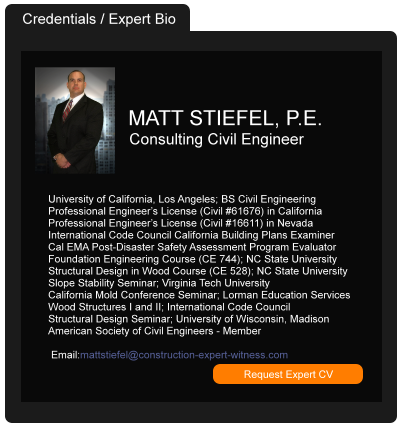Law Firm Settles Two Construction Defect Suits for a Combined $4.7 Million
October 25, 2013 —
CDJ STAFFConstruction Lawyers, LLP has announced that it has settled two Florida construction defect suits, both of which were filed by condominium associations. The first of these involved the Estates at Park Central Condominium Association, a 244-unit condominium complex in Orlando Florida. The condominium association alleged leaks into balconies and garages, and deficiencies in stucco application. After nearly three years since the filing of the lawsuit, and only weeks before the trial was to begin, the case was settled for $2 million.
The second case has also spent the last three years in mediation, however its trial date was further away. The Grand Venezia Condominium Owners Association alleged construction defects including leaking roofs and windows, and improperly installed stucco, leading to dry rot and water damage. The condominium community comprises 336 units in Clearwater, Florida and the units were originally built as apartments. Here, the settlement with the contractor was for $2.75 million. A lawsuit against the developer continues.
Read the court decisionRead the full story...Reprinted courtesy of
Connecticut Court Holds Unresolved Coverage Issues Makes Appraisal Premature
July 18, 2018 —
Michael S. Levine, Lorelie S. Masters & Geoffrey B. Fehling – Hunton Insurance Recovery Law BlogA Connecticut court recently denied a motion to compel appraisal of a claim for coverage of a commercial property damage claim, holding that, where the insurance policy at issue provides for appraisal of disputes related to the value or quantum or a loss suffered—not the rights and liabilities of the parties under the policy—appraisal is premature. The decision relied on law that equates insurance appraisal to arbitration and follows a number of decisions holding that parties cannot expand the scope of appraisal clauses to resolve questions of coverage or liability where, as in this case, those issues are not supported by the applicable policy language.
Reprinted courtesy of Hunton Andrews Kurth attorneys
Michael S. Levine,
Lorelie S. Masters and
Geoffrey B. Fehling
Mr. Levine may be contacted at mlevine@HuntonAK.com
Ms. Masters may be contacted at lmasters@HuntonAK.com
Mr. Fehling may be contacted at gfehling@HuntonAK.com
Read the court decisionRead the full story...Reprinted courtesy of
Client Alert: California’s Unfair Competition Law (B&P §17200) Preempted by Federal Workplace Safety Law
September 24, 2014 —
R. Bryan Martin, Yvette Davis, & Kristian Moriarty - Haight Brown & Bonesteel LLPIn Solus Industrial Innovations LLC v. Superior Court (No. G047661, filed 9/22/2014) (“Solus”) the California Court of Appeal, Fourth Appellate District, held California’s Unfair Competition Law (Business & Professions Code §17200) is preempted by the federal Occupational Safety and Health Act of 1970 (“Fed/OSHA”) because the Unfair Competition law, as approved by the United States Secretary of Labor, does not include any provision for civil enforcement of workplace safety standards by a state prosecutor through a complaint for penalties.
Solus Industrial Innovations, LLC (“Solus”) is a plastics manufacturer. In 2007, Solus installed a residential water heater at its commercial facility in Orange County. The water heater exploded in March 2009, killing two workers. California’s Division of Occupational Safety and Health (“Cal/OSHA”) investigated and determined the explosion was caused by a failed safety valve and lack of any proper safety feature on the water heater. Cal/OSHA charged Solus with five violations of Title 8 of the California Code of Regulations. Because deaths were involved, Cal/OSHA forwarded the results of its investigation to the Orange County District Attorney.
In March 2012, the Orange County District Attorney filed criminal charges against Solus’ plant manager and maintenance supervisor. The District Attorney also filed a civil action against Solus, including two causes of action for violation of California Business & Professions Code §17200 – the Unfair Competition Law (“UCL”). The action sought civil penalties under the UCL in the amount of $2,500 per day, per employee, from November 29, 2007 through March 19, 2009.
Reprinted courtesy of Haight Brown & Bonesteel LLP attorneys
R. Bryan Martin,
Yvette Davis and
Kristian Moriarty
Mr. Martin may be contacted at bmartin@hbblaw.com
Ms. Davis may be contacted at ydavis@hbblaw.com
Mr. Moriarty may be contacted at kmoriarty@hbblaw.com
Read the court decisionRead the full story...Reprinted courtesy of
Large Canada Employers and Jobsites Mandate COVID-19 Vaccines
November 08, 2021 —
Scott Van Voorhis - Engineering News-RecordThe push for COVID-19 vaccine mandates is gaining traction in Canada’s construction industry, with governments, large project sites and major employers setting new inoculation deadlines.
Reprinted courtesy of
Scott Van Voorhis, Engineering News-Record
ENR may be contacted at enr@enr.com
Read the full story... Read the court decisionRead the full story...Reprinted courtesy of
CDJ’s #2 Topic of the Year: Ewing Constr. Co., Inc. v. Amerisure Ins. Co., 2014 Tex. LEXIS 39 (Tex. Jan.17, 2014)
December 31, 2014 —
Beverley BevenFlorez-CDJ STAFFEwing received quite a bit of attention around the blogosphere, and Tred R. Eyerly of Damon Key Leong Kupchak Hastert wrote a nicely succinct case summary on his blog, Insurance Law Hawaii:
“In a much anticipated decision, the Texas Supreme Court ruled that a general contractor who agrees to perform its work in a good and workmanlike manner does not "assume liability" for damages arising out of its defective work so as to trigger the Contractual Liability Exclusion.”
Read the court decisionRead the full story...Reprinted courtesy of
Dangerous Condition, Dangerous Precedent: California Supreme Court Expands Scope of Dangerous Condition Liability Involving Third Party Negligent/Criminal Conduct
August 19, 2015 —
R. Bryan Martin, Laura C. Williams, & Lawrence S. Zucker II – Haight Brown & Bonesteel LLPIn Cordova v. City of Los Angeles (filed 8/13/15, Case No. S208130), the California Supreme Court held a government entity is not categorically immune from liability where the plaintiff alleges a dangerous condition of public property caused the plaintiff’s injury, but did not cause the third party conduct which precipitated the accident.
The case arises out of a traffic collision by which the negligent driving of a third party motorist caused another car to careen into a tree planted in the center median owned and maintained by the City of Los Angeles (“City”). Of the four occupants in the car that collided with the tree, three died and the fourth was badly injured. The parents of two of the occupants sued the City for a dangerous condition of public property under Government Code Section 835. The plaintiffs alleged the roadway was in a dangerous condition because the trees in the median were too close to the traveling portion of the road, posing an unreasonable risk of harm to motorists who might lose control of their vehicles.
The City successfully moved for summary judgment, which plaintiffs appealed. On review, the Court of Appeal affirmed holding the tree was not a dangerous condition as a matter of law because there was no evidence that the tree had contributed to the criminally negligent driving of the third party motorist.
Reprinted courtesy of Haight Brown & Bonesteel LLP attorneys
R. Bryan Martin,
Laura C. Williams and
Lawrence S. Zucker II
Mr. Martin may be contacted at bmartin@hbblaw.com
Ms. Williams may be contacted at lwilliams@hbblaw.com
And Mr. Zucker may be contacted at lzucker@hbblaw.com
Read the court decisionRead the full story...Reprinted courtesy of
South Carolina Legislature Redefining Occurrences to Include Construction Defects in CGL Policies
April 01, 2011 —
Beverley BevenFlorez CDJ STAFFThe question of what circumstances must be in place for construction defects to be covered in a general commercial liability (CGL) policies is being raised by the courts and the legislature in South Carolina. The Insurance Journal reports that the American Insurance Association as well as the Property and Casualty Insurers Association of America are speaking out on the issue.
The problem seems to be centered on what defines an “occurrence.” CGL policies were not meant to cover faulty workmanship, according to the filing by the South Carolina Supreme Court. In January of this year, the South Carolina Supreme Court reversed the ruling in Crossmann Communities v Harleysville Mutual declaring that “Respondents cannot show the damage here was the result of an occurrence. Rather, the damage was a direct result and the natural and expected consequence of faulty workmanship; faulty workmanship did not cause an occurrence resulting in damage.” They focused their attention on the word “accident,” stating that there is a fortuity element that is not diminished.
�The South Carolina legislature reacted by producing a bill that would add new language directly negating the ruling by the Supreme Court. The South Carolina bill S-431 would change the definition of an occurrence in regards to construction defects as follows: “For a liability insurance policy issued to a construction professional, an ‘occurrence’ means, at a minimum: (1) an accident; or (2) continuous or repeated exposure to substantially the same general harmful condition or substance. No additional requirement of a fortuitous event is needed to constitute an ‘occurrence.’”
�S-431 is currently residing in the House Committee on Labor, Commerce and Industry.
�Read the full story...
Read the court decisionRead the full story...Reprinted courtesy of
Am I Still Covered Under the Title Insurance Policy?
May 01, 2019 —
Ian Douglas - Snell & Wilmer Real Estate Litigation BlogWhen transferring property for corporate restructuring or estate planning purposes, an important issue to consider is whether the successor owner will be covered by the grantee’s title insurance policy. Because title insurance policies insure only the title of the “Insured” identified in the policy, the successor in interest of the named insured may not be covered following the transfer.
In older ALTA title insurance policies, the definition of “Insured” included the person or entity specifically identified in the policy as the insured, as well as any subsequent owners who took title to the subject property by operation of law. Because those policies did not clarify what the term “by operation of law” meant, it was unclear whether certain subsequent owners, such as a parent or subsidiary of the original insured, fell within the definition of “Insured”. In order to avoid any risk that a subsequent owner following a transfer between related parties was not covered by the grantor’s title policy, parties often obtained an “additional insured” endorsement which provided the subsequent owner coverage under the original policy.
Read the court decisionRead the full story...Reprinted courtesy of
Ian Douglas, Snell & WilmerMr. Douglas may be contacted at
idouglas@swlaw.com


































































